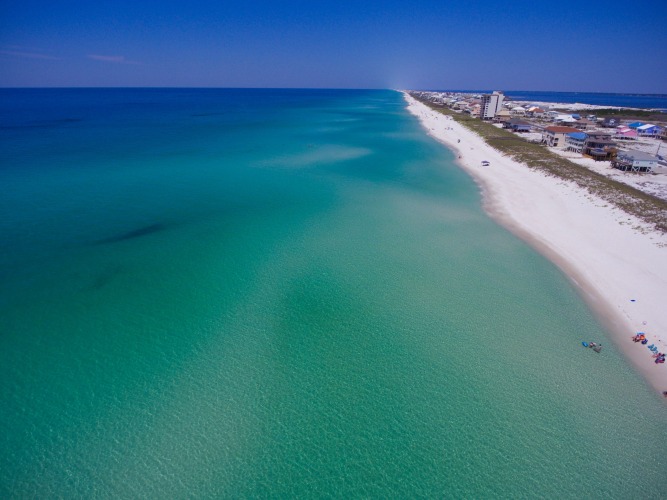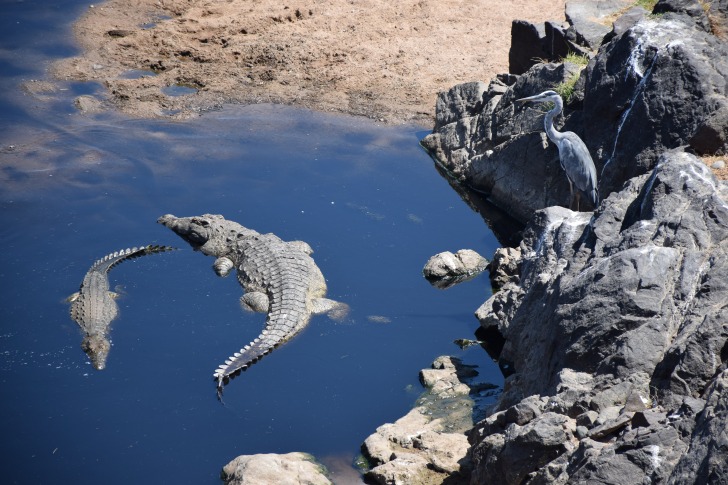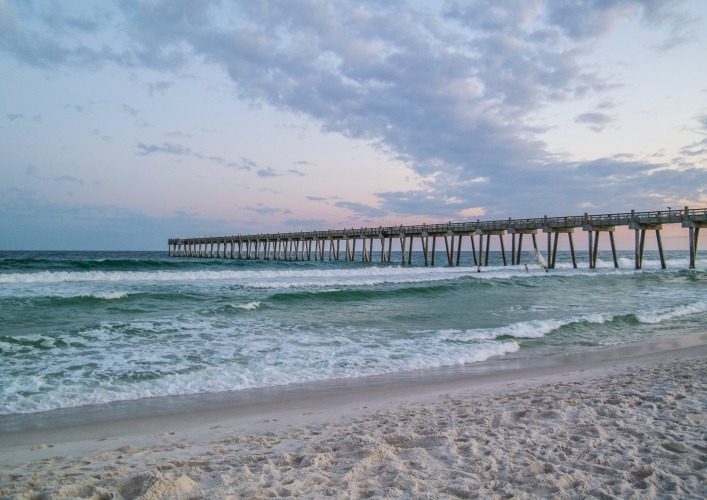Situated on the Gulf of Mexico coast in the Florida Panhandle near the Alabama border, Pensacola, Florida, has changed flags from Spanish to French, British, Confederate, and American flags five times in its history.
As a result, Pensacola is known as The City of Five Flags which has become woven into the fabric of society, even today.
The city features over 50 miles of picturesque coastline, including crystal clear bays and emerald-green Gulf waters.
Over time, Pensacola has become a combination of a bustling metropolitan center and a relaxed beach town with a high quality of life for residents.
Visitors and new residents are surprised to learn that alligators live within the Pensacola area.
To learn more about the alligators that call Pensacola home, keep reading!

Contents
So… Are There Alligators in Pensacola?
The short answer is, yes, some alligators live in Pensacola.
However, it’s rare to find them near the coastline since they prefer freshwater habitats.
Instead, you may find them in the upper part of Pensacola Bay, where the saltwater has diluted into freshwater.
They are more common inland in freshwater ponds and rivers north of the city.
Alligators have been known to cross the sound from the mainland onto Pensacola Beach and enter the Gulf of Mexico, but they won’t stay long.
Alligator Species in Pensacola
The only alligator species in Pensacola is the American Alligator, one of two species left in the world.
This is the same species that live in the entire southeastern and south-central part of the U.S., from North Carolina to Texas.
Is it Safe to Swim in Pensacola?
While alligators have occasionally been known to attack humans when they feel threatened or individual ventures too close to their young, this is an atypical occurrence.
However, those who are unfamiliar with alligators think they are aggressive, they are quite timid that try to stay away from humans and keep to themselves.
Unfortunately, there are plenty of other dangers when swimming in the Gulf of Mexico along the Florida panhandle or inland lakes and rivers.
These include:
Dangerous Rip Currents
Rip currents are present in oceans and lakes around the world.
They can occur at any time, with undertows being stronger on some days than others.
Rip currents fast-moving currents that move away from short and can pull swimmers out to see quickly.
Since rip currents flow underwater, they cannot be detected from the surface.
However, there are a few identifiers, such as looking for a line of foam moving out to sea, a break in wave patterns, differences in watercolors, and choppy water flowing at acute angles toward shore.
Harmful Sun Rays
While many beachgoers emphasize low-risk scenarios of being attacked by animals and sea life while swimming, they fail to consider a high-risk threat to their body: the harmful UV rays from the sun.
As a result, visitors are susceptible to severe burns without proper beach gear and sunscreen even on cloudy days in the early and late beach season.
Worst of all, since swimmers enjoy the comfortable water, they are unaware of the heat and reflection, which magnifies the rays causing terrible burns.
Prolonged exposure can lead to skin cancer, so applying sunscreen every 20 minutes or after each dip is crucial.
Jellyfish
Pensacola is susceptible to jellyfish swarm, which is when a large number of jellyfish navigate toward the coastline.
When this occurs, beach officials raise a purple flag, which prevents beachgoers from swimming in the water.
The larger concern is when a stray jellyfish comes near the coastline, and it isn’t easy to see since they are clear.
A jellyfish sting can be incredibly painful and requires immediate medical attention.
Swimmers must also be aware of Portuguese man o’ war which injects venom requiring medical aid.
Jellyfish swim underwater, so they are difficult to see while Portuguese man o’ war float on the top of the water with tentacles under the surface.
Both creatures can continue stinging after death, so never touch one lying on the beach and exit the water immediately if you see either.
Nasty Weather
While Florida generally has nice weather, squalls and other inclement weather can come out of nowhere, given its subtropical climate.
Swimming in nasty weather can pose a danger, especially if thunderstorms and lightning are in the area.
If a storm is approaching, it’s best to seek cover inside a vehicle or enclosed structure and stay away from the windows.
Also, the Gulf is highly susceptible to hurricanes from spring through fall, so swimming during this powerful storm can result in rocky waters, the chance of being struck by lightning, and unpredictable currents.
Even the best swimmers can struggle with remaining above water during quick storms.
While shark attacks occur more often than alligator attacks, they are still rare.
Most human-shark encounters occur because the shark thinks a human is sea life, with most attacks occurring close to the shoreline between sandbars and drop-offs.
Although many tips for avoiding sharks exist, when lifeguards advise swimmers to exit the water immediately, listening and getting to shore as fast as possible is critical.

Interesting Alligator Facts in Pensacola
Scientists enjoy studying the American alligator because they are such unique creatures.
Some of the most interesting facts include:
Diet
Alligators are carnivores, but recent studies have shown that they consume fruit.
Seeds fall off during gathering and eating fruit, so American alligators help spread fruit seeds, thus improving the local ecosystem.
Growth
Alligators are constantly growing throughout their lives, which is why they are at their largest when they reach old age.
The further north you travel towards North Carolina, the smaller the American alligator becomes.
Hunting
Alligators gather and place sticks, leaves, and branches on their head to attract birds looking for nesting items.
Once the bird swoops toward the alligator, they quickly catch and eat them.
Movement
The American alligator can swim, walk, run, or crawl on land to escape dangerous situations or hunt its prey.
They also have two walk types, the high walk, which lifts their body off the ground, and the low walk, which is a more sprawling movement when creeping up on an animal.
Teeth
At any given time, the American alligator has 74 to 80 teeth in their mouth.
However, alligators can go through around 2,000 teeth during their lifetime since they grow new teeth when others are worn or fall out.
Vocality
Alligators are some of the most vocal creatures in the local environment, with different calls to signal distress, find mates, declare territory, and threaten competitors.
They make different sounds by sucking and releasing air.
However, the most common call that humans understand is hissing, which is a great indication to stay away.
Alligators vs. Crocodiles
Alligators are crocodiles are the two closest creatures to dinosaurs.
They have been on this Earth for around 70 million years, and since then, the behavior and appearance of these living fossils have changed little.
However, alligators and crocodiles have nine distinct differences that help the average viewer tell them apart, including:
Behavior
While alligators generally want to be left alone, crocodiles are significantly more aggressive and attack humans more often.
Crocodiles will go after anything that moves, making them opportunistic predators.
Bite
Crocodiles have a significantly more powerful bite with sharper and pointier teeth to tear apart their prey.
The alligator’s jaw was made for crushing prey, so they have cone-shaped teeth instead of pointed ones.
Color
One of the simplest ways to tell the two creatures apart is by their color.
Crocodiles are black, brown, grey, or green with a speckled pattern that helps them blend.
American alligators are shiny dark green that can appear black in certain lighting.
This means they are significantly darker in color than crocodiles.
Alligators also have tiny black spots near their jaw, which helps them detect ripples and regulate water pressure during swimming.
Habitat
Alligators typically live closer to shore, with natural habitats being low-flow areas of rivers, lakes, and swamp lands, but not saline waters.
Crocodiles live in wetlands and marshes along lakes and rivers but can live in salty waters.
While both species are cold-blooded, crocodiles require higher temperatures to survive.
Size
Crocodiles tend to be much larger than alligators, with lengths of up to 23 feet.
The American crocodile can reach a maximum size of 20 feet, averaging between 15 and 17 feet.
Snout
Crocodiles have V-shaped snouts, whereas alligators have snouts shaped like a ‘U.’
All crocodile species have this same snout shape and can be wide or narrow.
Their jaws close from the top down, exposing the top and bottom sets of teeth.
An alligator’s jaw closes downward, exposing only its top teeth set.
Species
Crocodiles have 13 distinct species, while alligators only have two: the American alligator and the Chinese alligator.
Millions of American alligators exist in the southeastern part of the United States, whereas only a few thousand Chinese alligators are alive.
Efforts are underway in China to get the species off the endangered list.
3 Safety Tips for Swimming in Alligator-Infested Waters
When considering swimming in alligator-infested waters, there are three tips to follow:
Tip One: Don’t swim in alligator-infested waters
The simplest way to avoid an encounter with an alligator while swimming is to avoid swimming in the same body of water where they reside or have been spotted.
This means they could have their young near, which would be a provocation and result in an attack.
Tip Two: Don’t wear anything shiny
If you’ve decided to skip the first tip and want to swim with the gators, don’t wear shiny items that could appear like fish reflecting in the sun.
Tip Three: Never corner a gator
The American alligator is shy, so it’s much more scared of you and doesn’t want to be near humans.
Therefore, if you spot one while swimming, don’t go near it and try to corner the creature.
This will cause the gator to feel threatened and attack you.
Summary
The American alligator is less threatening than a crocodile or shark.
If you’re in a freshwater area in Pensacola, you don’t need to worry about crocodiles emerging from nowhere and attacking you since they live in more saline waters.
Alligators are much shyer and want to be as far away from you as you want to be from them.
However, if they feel provoked or you’re threatening their young, they will attack.
So the best advice is if local Pensacola officials tell you not to swim or to stay away from a specific area due to alligators, it’s best to listen and not push your luck!
Pensacola Safety Overview
READ THE FULL REPORT: Pensacola Safety Review
Safety Index:
- OVERALL RISK: MEDIUM
- TRANSPORT & TAXIS RISK: LOW
- PICKPOCKETS RISK: MEDIUM
- NATURAL DISASTERS RISK: MEDIUM
- MUGGING RISK: MEDIUM
- TERRORISM RISK: MEDIUM
- SCAMS RISK: LOW
- WOMEN TRAVELERS RISK: LOW
Frequently Asked Questions
What part of Florida has no alligators?
The only area in the state where no alligators exist is Central Florida, which is home to freshwater spring-fed rivers.
Big Bend Saltwater Paddling Trail and Withlacoochee are two examples of areas in the central part of the state frequented by tourists and don’t have alligators.
What Florida city has the most alligators?
Gainesville, Florida, home to the University of Florida Gators (for a reason), has the most gators within its city limits.
This area is ripe with marshes, swamps, lakes, and freshwater rivers, which is the exact habitat for an alligator.
What part of Florida has the most alligators?
There are estimated millions of alligators in South Florida due to Everglades National Park, which is a massive area of protected land.
The Florida Wildlife Commission estimates that Lake George in northwest Florida has the most in a single small area with around 2,300.
Lake Kissimmee near Orlando is a close second with approximately 2,000 alligators.











